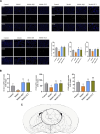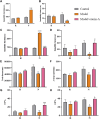Jingqianshu granules mitigates premenstrual depression by regulating orexin signaling
- PMID: 38948463
- PMCID: PMC11211579
- DOI: 10.3389/fphar.2024.1294122
Jingqianshu granules mitigates premenstrual depression by regulating orexin signaling
Abstract
Introduction: Premenstrual dysphoric disorder (PMDD), a severe form of premenstrual syndrome (PMS), is a serious health disorder that affects patient moods. It is caused by cyclic psychological symptoms and its pathogenesis is still unclear. Abnormalities in the basolateral amygdala (BLA) orexin system, which are important causes of the development of depressive mood, have not been reported in PMDD, so exploring its intrinsic mechanisms is meaningful for enriching the pathomechanisms of PMDD. Methods: High performance liquid chromatography was used for the determination of the active ingredients of Jingqianshu granules. Developing a rat model of premenstrual depression using the forced swimming test (FST). The experiment consisted of two parts. In Part 1, the rats were divided into the control group, the model group, the model + Jingqianshu group, and the model + fluoxetine group. The FST, open field test, and elevated plus maze test, were used to assess the behavior of the rats as well as to evaluate the effect of drug intervention. Immunofluorescence and RT-qPCR were used to detect the expression of orexin and its receptors OX1R and OX2R genes and proteins. The expression of Toll-like receptor 4, nuclear factor kappa-B, tumor necrosis factor-α, interleukin 6, and interleukin-1β in the BLA brain region was detected by Western-Blot. In part 2, the rats were injected intracerebrally with orexin-A. Observe the behavioral activities of rats in the control group, model group, and model+orexin-A group. Immunofluorescence was used to detect microglia in the BLA area of rats, and the expression levels of the above inflammatory factors were detected by Western-Blot. Results: The five components of Jingqianshu granules are: paeoniflorin, erulic acid, liquiritin, hesperidin, and paeonol. During the estrous cycle, rats exhibited depressive-like behavior during the non-receptive phase of the behavioral test, which disappeared during the receptive phase. Immunofluorescence and RT-qPCR showed reduced gene and protein expression of orexin, OX1R, and OX2R in the BLA region of rats in the model group.WB showed elevated levels of inflammatory factors. All returned to control levels after drug treatment. In part 2, injection of orexin-A into the BLA brain region of model rats resulted in reduced immunoreactivity of microglia and decreased expression levels of inflammatory factors. Discussion: Jianqianshu granules can achieve the purpose of treating premenstrual depression by regulating orexin-mediated inflammatory factors, which provides a new idea for further research on the pathogenesis of PMDD. However, the current study is still preliminary and the pathogenesis of PMDD is complex. Therefore, more in-depth exploration is needed.
Keywords: Jingqianshu granules; OX1R; OX2R; inflammatory factor; orexin; premenstrual.
Copyright © 2024 Dong, Dai, Zhao, Gong, Weng, Lv, Zhao, Du, Ma, Zhang, He, Zheng and Sun.
Conflict of interest statement
Author CD was employed by Qinhuangdao Shanhaiguan Pharmaceutical Co., Ltd. The remaining authors declare that the research was conducted in the absence of any commercial or financial relationships that could be construed as a potential conflict of interest.
Figures









Similar articles
-
A forced swim-based rat model of premenstrual depression: effects of hormonal changes and drug intervention.Aging (Albany NY). 2020 Nov 21;12(23):24357-24370. doi: 10.18632/aging.202249. Epub 2020 Nov 21. Aging (Albany NY). 2020. PMID: 33229622 Free PMC article.
-
Resident intruder paradigm-induced PMDD rat model of premenstrual irritability: behavioral phenotypes, drug intervention, and biomarkers.Aging (Albany NY). 2022 Nov 27;14(22):9210-9220. doi: 10.18632/aging.204402. Epub 2022 Nov 27. Aging (Albany NY). 2022. PMID: 36441533 Free PMC article.
-
Xiangshao Granules reduce the aggressive behavior and hippocampal injury of premenstrual irritability in rats by regulating JIK/JNK/p38 signal pathway.J Ethnopharmacol. 2023 Apr 6;305:116061. doi: 10.1016/j.jep.2022.116061. Epub 2022 Dec 25. J Ethnopharmacol. 2023. PMID: 36577489
-
[Premenstrual dysphoric disorder (PMDD): Drug and psychotherapeutique management, a literature review].Encephale. 2024 Apr;50(2):211-232. doi: 10.1016/j.encep.2023.08.007. Epub 2023 Oct 9. Encephale. 2024. PMID: 37821319 Review. French.
-
Orexin in sleep, addiction and more: is the perfect insomnia drug at hand?Neuropeptides. 2013 Dec;47(6):477-88. doi: 10.1016/j.npep.2013.10.009. Epub 2013 Oct 23. Neuropeptides. 2013. PMID: 24215799 Review.
Cited by
-
The role of the neuroinflammation and stressors in premenstrual syndrome/premenstrual dysphoric disorder: a review.Front Endocrinol (Lausanne). 2025 Mar 28;16:1561848. doi: 10.3389/fendo.2025.1561848. eCollection 2025. Front Endocrinol (Lausanne). 2025. PMID: 40225329 Free PMC article. Review.
-
Efficacy and safety of Jingqianshu granules in patients with premenstrual syndrome: a multicenter, randomized, double-blind, placebo-controlled trial.Int J Clin Pharm. 2025 Jun 28. doi: 10.1007/s11096-025-01949-5. Online ahead of print. Int J Clin Pharm. 2025. PMID: 40580262
References
-
- Bertone-Johnson E. R., Ronnenberg A. G., Houghton S. C., Nobles C., Zagarins S. E., Takashima-Uebelhoer B. B., et al. (2014). Association of inflammation markers with menstrual symptom severity and premenstrual syndrome in young women. Hum. Reprod. 29 (9), 1987–1994. 10.1093/humrep/deu170 - DOI - PubMed
LinkOut - more resources
Full Text Sources
Miscellaneous

